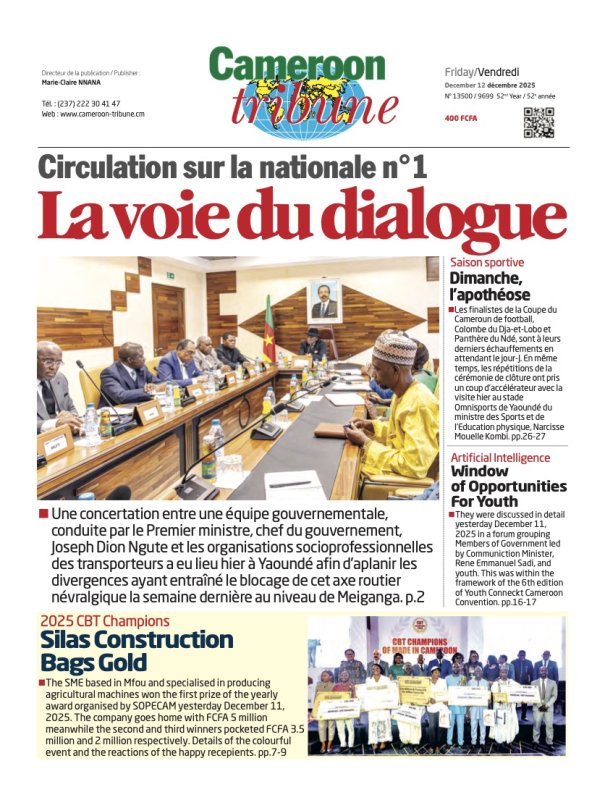Mining: Incorporating Local Processing Too!
- Par Godlove BAINKONG
- 04 Apr 2024 12:40
- 0 Likes
Ever since President Paul Biya announced the start of industrial mining in the country during his New Year State-of-the-nation’s address on December 31, 2022, there has been an avalanche of activities in the sector and hope-raising pronouncements by various stakeholders. His disclosure that, “In order to diversify State revenue sources, I authorised the implementation of three large-scale projects aimed at developing our mining potential, structuring our economy and creating jobs,” galvanised mining actors in the country to strive for the materialisation of the Presidential directives.
From when the announcement was made till date, field activities have multiplied with agendas set for diverse mining projects across the country. In effect, since 2023, Cameroon has been striving to go from simply being a country with huge mining potentials to a mining producer; in fact, a country that develops its mining resources to sustainably boost its socio-economic development. For keen observers, this sounds like a breakaway from the past.
The exploitation of the Kribi-Lobe iron ore which comprises the construction of an iron enrichment plant, an approximately 20-kilometre long pipeline and a 60-megawatt power plant has been in the news. The same holds for the trans-national Mbalam-Nabeba iron ore project as well as the exploitation of the Bipindi-Grand Zambi iron ore. These are the projects the Head of State made mention of in his 2023 New Year State-of-the nation’s address.
Going by the Acting Minister of Mines, Industries and Technological Development, Prof. Fuh Calistus Gentry (via an interview granted Cameroon Tribune), the Lolabe iron ore project manned by SINOSTEEL is fully on course. The company has reportedly mobilised almost 80 per cent of the complementary equipment for effective field work. There is also the Grand Zambi project which is said to be advancing steadily. Equally, the Mbalam and the Geovic projects were said to be undergoing restructuring to align with the others that had already started. Salutary developments which rekindle hopes of better days ahead for the country and people!
Authorities of the Ministry of Mines, Industries and Technological Development have been to Congo to finalize negotiations on the much-heralded Mbalam-Nabeba iron ore project and also to China and Brazil to discuss with development partners on these and other projects.
Even just recently, it was announced that mining of the Ngovayang iron ore deposit around Bipindi in the Ocean Division of the South Region will begin before January 2025. Cameroon Mining Action (CAMINA), the contracted company for the project, is said to be working tooth and nail to flag off real mining development. The announcement is promising as the Ngovayang mining project, the third in the Ocean Division, has an estimated resource of 800 million tonnes of iron. Pending confirmation of the data, proven reserves stand at 300 million tonnes of ore. Mining will reportedly begin with 44 million tonnes of ore to produce 7 million tonnes of iron concentrate. This could be a life-changer should the potentials be fully mined.
The visible effervescence is good at least; demonstrating the desire by officials vested with the powers to oversee the development of the country’s diverse mineral resources. Even more, breaking up with the apparent “paradox of plenty” where mining in most mineral-rich countries becomes a curse instead of a blessing to their people. It is common knowledge that although Cameroon’s subsoil is endowed with mineral resources, the non-oil mining sector accounts for merely 1% of Gross Domestic Product. A rather disturbing reality with the country’s 2035 long-term vision wherein Cameroon intends to develop a strong industrial and mining sector so as to rub shoulders with emerging or middle-income countries.
As efforts are redoubled for Cameroon to fully transform its huge mineral potentials into development tools to sustain the socio-economic growth of the country, serious thought and actions should be given to local processing in the different mineral projects. This starts from when mining contracts are negotiated. It should be a clause in the signed contract, groundwork fully set prior to real mining development and follow up strictly done to ensure effectiveness. An envisaged development of an iron and steel complex for the local processing of iron, the construction of a pipeline and several basic social facilities for the Bipindi-Grand Zambi iron ore project is a good example worth emulating in other projects.
This will create jobs and breed wealth for the countr...
Cet article complet est réservé aux abonnés
Déjà abonné ? Identifiez-vous >
Accédez en illimité à Cameroon Tribune Digital à partir de 26250 FCFA
Je M'abonne1 minute suffit pour vous abonner à Cameroon Tribune Digital !
- Votre numéro spécial cameroon-tribune en version numérique
- Des encarts
- Des appels d'offres exclusives
- D'avant-première (accès 24h avant la publication)
- Des éditions consultables sur tous supports (smartphone, tablettes, PC)











Commentaires